Last Updated on June 26, 2025 by Andy Walker
Arthritis pain can make every step a struggle, but the right footwear can make all the difference. Whether you have rheumatoid arthritis, osteoarthritis, or general joint stiffness, choosing supportive shoes can help reduce pain, improve mobility, and protect your joints. We’ve researched top-rated models that prioritize cushioning, shock absorption, wide toe boxes, and orthopedic support. This list includes walking shoes, cross-trainers, and everyday sneakers recommended by podiatrists and loved by users with arthritis. These shoes are ideal for easing pressure on your feet, knees, hips, and back. Explore our top picks to find the best match for your needs.
Also see our buyer’s guide: Click here
Summary: Best Shoes for Arthritis
Shoe Model | Best For | Arthritis Relief Features | Price |
|---|---|---|---|
Overall arthritis relief | Arch support, gel heel, air cushioning, wide toe box | ||
Walking and long-distance use | Shock absorption, slip-resistant sole, BioMoGo DNA cushioning | ||
Versatile training and casual wear | Firm fit, cushioned sole, great grip | ||
Running with joint support | GEL technology cushioning, breathable mesh, orthotic compatibility | ||
Budget-friendly comfort | Memory foam insole, breathable upper, padded collar | ||
Flat feet, bunions, hammertoes | Orthotic insole, extra depth, padded heel | ||
Daily walking for women | Arch and joint support, heel cushioning, secure fit |
Reviews of Best Shoes for Arthritis
Here are our top picks reviewed for best shoes for arthritis:
Orthofeet Women’s Coral Stretch Knit Sneakers
Best for: Overall arthritis relief
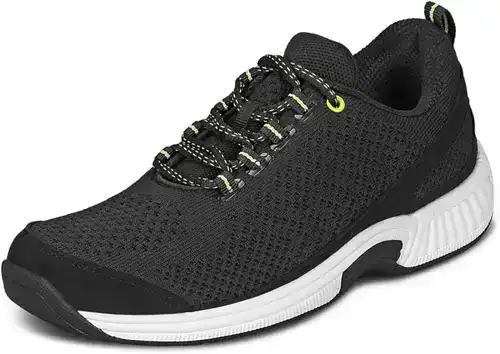
The Orthofeet Coral Stretch Knit Sneakers are designed for individuals seeking relief from arthritis-related foot discomfort. These sneakers feature a stretchable knit upper that conforms to the foot, providing a non-binding fit ideal for sensitive feet. The Ortho-Cushion System offers anatomical arch support and cushioned soles that soften each step, reducing pressure on joints. A wide toe box accommodates bunions and hammertoes, while the seam-free interior minimizes irritation. The lightweight design and air cushioning enhance mobility, making them suitable for daily wear. Users have reported significant pain relief and improved walking comfort.
Specs
- Material: Stretch knit upper
- Sole: Rubber
- Sizes: 5–12 (women’s)
Pros
- Excellent arch support
- Wide toe box for comfort
- Lightweight and breathable=
Cons
- Limited color options
- Higher price point
Men’s version (Edgewater) | Women’s version (Coral)
Brooks Men’s Addiction Walker 2 Walking Shoe
Best for: Walking and long-distance use

The Brooks Addiction Walker 2 is a supportive walking shoe designed for individuals with arthritis or foot ailments. It features BioMoGo DNA cushioning that adapts to your stride, providing comfort and reducing impact on joints. The Extended Progressive Diagonal Rollbar (PDRB) offers motion control and stability, aiding those with overpronation. A slip-resistant outsole ensures secure footing on various surfaces. The full-grain leather upper adds durability and a classic look. Users appreciate its all-day comfort and support during long walks or standing periods.
Specs
- Material: Full-grain leather upper
- Sole: Synthetic
- Sizes: 7–15 (men’s)
Pros
- Superior cushioning
- Excellent arch support
- Slip-resistant outsole
Cons
- Heavier than some alternatives
- Break-in period may be required
Men’s version | Women’s version
Nike Men’s Air Monarch IV Cross Trainer
Best for: Versatile training and casual wear
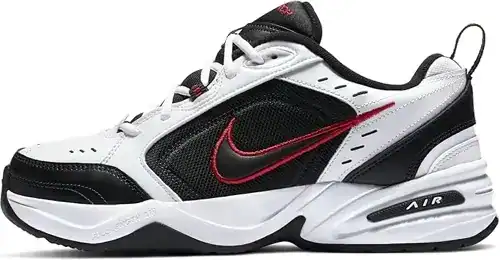
The Nike Air Monarch IV is a versatile cross-training shoe that combines comfort and durability. Its leather upper provides support and longevity, while the full-length Phylon midsole offers lightweight cushioning. The solid rubber outsole ensures traction on various surfaces. This shoe is known for accommodating wider feet and providing a stable platform, making it suitable for individuals with arthritis seeking everyday comfort. However, some users have noted that the shoe can be heavy and may produce squeaking noises over time.
Specs
- Material: Leather upper
- Sole: Rubber
- Sizes: 6–15 (men’s)
Pros
- Durable construction
- Good arch support
- Affordable price point
Cons
- Heavier than some alternatives
- Potential for squeaking noises
Men’s version | Women’s version
ASICS Gel-Venture 10 Trail Running Shoes
Best for: Running with joint support
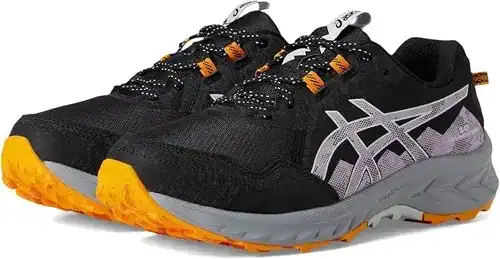
The ASICS Gel-Venture 10 is the newest evolution of the Gel-Venture series, tailored for runners and walkers who need extra support for joint discomfort like arthritis. It features a cushioned AMPLIFOAM™ midsole and rearfoot GEL® technology, which together deliver excellent shock absorption to reduce pressure on sensitive joints. The outsole is designed for trail conditions but works equally well on pavement, offering dependable traction across varied surfaces.
Breathable mesh construction helps regulate temperature, while supportive synthetic overlays provide structure without adding weight. The fit is secure, with plenty of room in the toe box to minimize pressure on arthritic toes or bunions. Although it’s a trail runner, this shoe’s balance of flexibility, support, and cushioning makes it a strong everyday shoe for anyone needing relief from joint strain.
Whether you’re heading out for a hike or running errands, the Gel-Venture 10 provides consistent support and a stable stride, all at an accessible price point.
Specs
- Material: Mesh upper
- Sole: Rubber
- Sizes: Men’s 7–15, Women’s 5–12
Pros
- Enhanced cushioning with AMPLIFOAM™ and GEL® technology
- Trail-ready grip and stability
- Lightweight and breathable
Cons
- Less suited to highly technical trails
- Style options are modest
Men’s version | Women’s version
Skechers Men’s After Burn Memory Fit – Strike Off Lace-Up Sneaker
Best for: Budget-friendly comfort
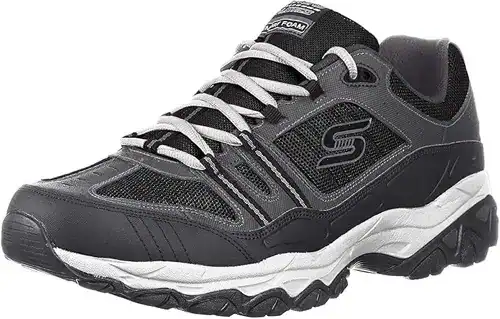
The Skechers After Burn Memory Fit sneaker offers a comfortable and affordable option for those with arthritis. It features a memory foam insole that conforms to the foot, providing cushioning and support. The leather and synthetic upper ensures durability, while the mesh fabric panels offer breathability. The flexible rubber outsole provides traction and stability. Users find this shoe suitable for daily wear and appreciate its comfort during extended periods of standing or walking.
Specs
- Material: Leather and synthetic upper
- Sole: Rubber
- Sizes: 6.5–16 (men’s)
Pros
- Affordable price
- Comfortable memory foam insole
- Breathable design
Cons
- May not provide enough arch support for some
- Durability concerns over time
Orthofeet Women’s Orthopedic Leather Arcadia Casual Shoes
Best for: Flat feet, bunions, hammertoes
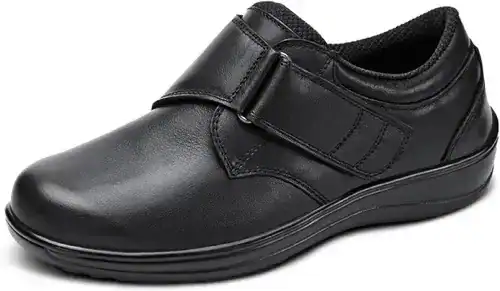
The Orthofeet Arcadia Casual Shoes are designed to alleviate foot pain associated with arthritis, flat feet, bunions, and hammertoes. They feature premium orthotic insoles with anatomical arch support and cushioning. The non-binding leather upper and extra depth design provide a relaxed fit, reducing pressure on sensitive areas. A wide toe box accommodates various foot shapes, and the seam-free interior minimizes irritation. Users report significant relief from foot pain and improved comfort during daily activities.
Specs
- Material: Leather upper
- Sole: Rubber
- Sizes: 5–12 (women’s)
Pros
- Excellent arch support
- Accommodates various foot conditions
- Durable leather constructionamazon.com
Cons
- Limited style options
- Higher price point
Men’s version | Women’s version
Ryka Women’s Devotion Plus 3 Walking Shoe
Best for: All-day walking comfort and joint support
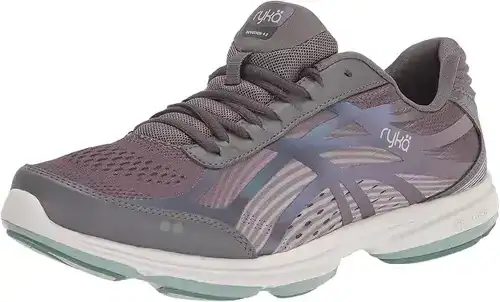
The Ryka Devotion Plus 3 is an evolution of the popular Devotion line, built specifically for women who need comfort and joint support during extended walking. It features RE-ZORB® cushioning technology in both the midsole and insole, helping to absorb shock and reduce stress on the feet, knees, and hips—ideal for arthritis sufferers. The breathable mesh upper allows for airflow, while the synthetic overlays add structural support without bulk.
This shoe is engineered specifically for the shape of a woman’s foot, with a narrower heel and roomier forefoot. The anatomical insole provides targeted arch and heel support, helping to relieve pressure and promote healthier alignment. The eight-piece rubber outsole enhances traction and stability on a variety of surfaces, making it suitable for both indoor and outdoor walking routines.
The Devotion Plus 3 is praised for its lightweight feel and immediate comfort, requiring little to no break-in period. For women seeking stylish, cushioned, and arthritis-friendly walking shoes, it remains a dependable choice.
Specs
- Material: Breathable mesh upper with synthetic overlays
- Sole: Rubber
- Sizes: Women’s 5–12, including wide widths
Pros
- RE-ZORB® cushioning for joint protection
- Designed for a woman’s foot shape
- Supportive anatomical insole
- Lightweight and breathable
Cons
- Wide sizes may feel too roomy for narrow feet
- Fewer color choices than previous models
Buyer’s Guide: Choosing the Right Shoes for Arthritis Relief
If you live with arthritis, the right pair of shoes can be more than just comfortable—they can transform your ability to move through your day. Whether you’re managing osteoarthritis, rheumatoid arthritis, or general joint stiffness, wearing footwear that reduces stress on your joints can improve your posture, reduce pain, and even enhance balance. Choosing the wrong shoes, on the other hand, can aggravate symptoms, cause misalignment, and lead to additional discomfort in your knees, hips, and back.
Here is what makes a shoe arthritis-friendly—so you can make the most informed decision when investing in your next pair.
Why Shoe Choice Matters for Arthritis
When you have arthritis, your joints are already inflamed and sensitive to pressure. That means each step can send painful shockwaves through your feet, knees, and hips—especially if you’re wearing shoes that don’t provide adequate cushioning or support.
Footwear that is properly cushioned, fitted, and supportive can reduce joint impact, minimize fatigue, and stabilize your gait. On the flip side, shoes that are too flat, too stiff, or too tight can increase inflammation and even contribute to long-term joint damage. Shoes aren’t just accessories—they’re part of your pain management plan.
Shock Absorption to Reduce Joint Impact
One of the most important features of arthritis-friendly footwear is shock absorption. When you walk or run, each footfall creates impact that travels up through your heel, into your ankle, and then up to your knee, hip, and spine. In someone with arthritis, these joints can’t tolerate that repetitive stress without inflammation flaring up.
Look for shoes that use advanced cushioning technology—like EVA foam, RE-ZORB®, or AMPLIFOAM™—to soften the blow. Rearfoot GEL® inserts, memory foam footbeds, and padded heel collars all work together to absorb shock and create a smoother walking experience. The thicker the midsole (without being overly rigid), the better the cushioning.
These features are particularly beneficial for people with heel pain, plantar fasciitis, or knee arthritis, and can make a dramatic difference in long-term mobility.
Arch Support That Promotes Alignment
Arch support does more than just comfort the middle of your foot—it helps realign your entire lower body. When your arches collapse, your feet overpronate (roll inward), placing uneven stress on your knees and hips. Over time, this misalignment can worsen arthritis symptoms and lead to joint instability.
To counteract this, arthritis-friendly shoes should include either built-in orthotic insoles or a removable footbed that allows for custom inserts. A firm but cushioned midsole will prevent your arches from flattening with every step. Heel cups that keep your foot positioned properly and prevent lateral wobbling also help stabilize your stride.
The best models offer support tailored to flat feet, high arches, or neutral arches. If you’re not sure what type you have, visiting a podiatrist or a specialty shoe store for a gait analysis is a smart step before you shop.
Soft, Breathable, and Flexible Material
Materials make a major difference when it comes to arthritic comfort. Shoes that are stiff, rigid, or rough on the inside can increase pain by creating friction and pressure points. When you’re managing arthritis, especially in the feet or ankles, you want materials that move with you, not against you.
Uppers made of breathable mesh, stretch-knit fabric, or flexible leather provide adaptability and reduce irritation. Seam-free interiors protect sensitive areas—like bunions, calluses, or swollen toes—from chafing. Breathability also reduces moisture buildup, which helps prevent fungal infections and skin irritation that people with arthritis are more prone to due to reduced mobility or circulation.
Bonus: Lightweight materials also reduce fatigue when worn for extended periods.
Roomy Toe Boxes Prevent Pressure Points
Toe pain is a common complaint among people with arthritis—especially in conditions like rheumatoid arthritis, which can cause joint swelling, deformities, or nodules. Shoes with tight or narrow toe boxes can squeeze the forefoot, leading to painful friction or the worsening of bunions, hammertoes, or overlapping toes.
That’s why a wide or extra-wide toe box is essential. Look for shoes that describe themselves as “extra depth” or “anatomical fit,” and avoid sharply pointed toe shapes. A round or naturally shaped toe area allows your toes to spread out comfortably, reducing tension and allowing better blood flow.
This is especially important if your arthritis causes your feet to swell during the day. Roomy toe boxes ensure that your shoes still feel good at the end of the day—not just the beginning.
Easy Entry and Adjustability
Many people with arthritis also experience stiffness or reduced mobility in their hands and fingers, making traditional laces hard to manage. Shoes with adjustable closures make your daily routine easier and help avoid frustration.
Look for models that feature hook-and-loop (Velcro) straps, elastic no-tie laces, toggle systems, or side zippers. These systems let you get your shoes on and off quickly without having to wrestle with fine motor tasks. More importantly, they allow you to adjust the fit across the top of the foot and around the ankle, which is key if your feet swell during the day or need more space in certain areas.
If you prefer a lace-up style, consider shoes with long laces and wide eyelets that require less dexterity to use. Some brands even offer double-closure systems for extra security without the hand strain.
Match the Shoe to Your Activity
Not all arthritis shoes are created equal—some are better for walking, while others are optimized for trail use, work environments, or casual wear.
If you’re on your feet for long periods during the day, look for walking shoes with deep cushioning and strong arch support. These often have rocker soles, which help guide your foot through the walking motion with less effort. For active users, trail or running shoes with advanced tread and shock absorption offer better grip and protection on uneven terrain.
Need something more versatile? Orthopedic casual shoes or sneakers often combine medical-grade support with styling that works for the office or running errands. Think leather uppers with a hidden orthotic footbed—so you’re getting the comfort you need without compromising on appearance.
Choose a shoe designed for your lifestyle, not just your foot type.
Prioritize Traction and Stability
For anyone with joint instability, the risk of falling is a serious concern. Arthritis can affect balance and coordination, especially in the hips, knees, and ankles. The last thing you want is a shoe that slips on tile or feels unstable on gravel or grass.
That’s why traction and grip matter. Rubber outsoles with deep lugs or patterned tread provide solid footing across different surfaces. Some shoes are marked “slip-resistant” or “non-skid”—a valuable feature for anyone walking on wet, polished, or uneven flooring.
Wide, flat soles and low heel heights also improve balance, especially for seniors or those with a history of falls. If you feel wobbly in your current shoes, it’s time to invest in a pair designed for sure-footedness.